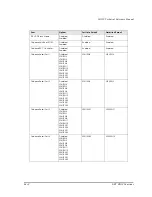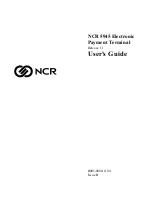
Rev.C
5-11 BIOS Functions
IR-320
Technical Reference Manual
Integrated Peripherals Menu
This menu sets the items related to I/O ports such as the IDE controller, the transfer mode, the
serial ports, and the parallel port.
Table 5-7 Integrated Peripherals menu
Items
Description
On-chip Primay/
Secondary PCI
IDE
This setting is to enable/disable the IDE controller housed in the chip set (ICH2). All of the default
settings are set as "Enabled". Always use the default "Enabled" setting.
If the "Disabled" settings are used, the IRQ resources are released and become available for
other devices. If the IRQ resources that are released, IRQ-14 is released for the primary and IRQ-
15 for the secondary.
IDE Primary/
Secondary:
Master/Slave
PIO
This setting sets the transfer mode for the IDE device connected to each interface. All of the
default settings are "Auto". The PIO is normally set as "Auto," but due to the auto detection
performed during POST, the optimum method used by the connection device is then set as
BIOS.
If devices in different modes are connected to the master and the slave, the transfer mode will
be fixed at a slow speed; therefore, it is necessary to pay particular attention to the connection
to each port. If a setting is made that exceeds the maximum mode supported by the device
connected, note that data errors may occur. If On-Chip Primary/Secondary PCI IDE is set to
"Disabled," the corresponding items cannot be selected.
IDE Primary/
Secondary:
Master/Slave
UDMA
This setting sets the DMA transfer mode for the IDE device connected to each interface. All
default settings are set as "Auto". The UDMA is normally set as "Auto, but due to the auto
detection performed during the POST, the DMA mode support status for the connection device
is determined as BIOS.
If any of the devices connected does not support DMA mode, the maximum mode that
device supports will be set. If On-Chip Primary/Secondary PCI IDE is set to "Disabled," the
corresponding items cannot be changed.
When using the UDMA, set as “Auto“
The transfer mode for the DMA mode compatible device connected to the IDE interface in
each OS can be changed to the DMA mode using the following methods. For BIOS settings, set
IDE ... UDMA to "Auto." This has been supported for the OS for EPSON.
1. Windows NT
Using a tool in Service Pack 6a, Refer to “Chapter 3“
2. Windows 98
Setting the OS, Refer to “Chapter 3“
3. Windows 2000
By applying Chip Set Driver, the mode can be automatically changed to
the DMA mode.
4. Windows XP
The DMA mode is automatically set upon installing the Windows XP
operating system.
USB Controller
This setting is used to enable/disable the USB controller housed in the chip set (ICH2).
The default setting is set as "Enabled".
Perform setting according to your system configuration (whether or not a USB device is
connected). If the "Disabled" setting is used, USB Keyboard Support can be selected and this
function is not supported. The PnP BIOS automatically determines the IRQ resource settings for
the USB controller.
USB Keyboard
Support
This setting enables/disables the emulation functions for the USB keyboard. The default setting is
"Disabled".
AC97 Audio
This setting enables/disables the audio controller housed in the chip set (ICH2).
The default setting is "Auto". Perform setting (using or not using the audio controller) according
to your system configuration.
Auto:
Choose this if the audio controller built in the chip set (ICH2) is used.
Disabled:
Choose this if the audio controller built in the chip set (ICH2) is not used.
The IRQ resources for the audio controller are allocated if the "Auto" setting is selected; they are
not allocated if the "Disabled" setting is selected.
Summary of Contents for IR-320
Page 1: ...Technical Reference Manual IR 320 Issued Date Issued by EPSON English 404368102 ...
Page 2: ......
Page 38: ...1 22 IR 320 System Overview Rev C ...
Page 260: ...4 80 Utilities Rev C ...
Page 294: ...5 34 BIOS Functions Rev C ...
Page 308: ...6 14 Device Diagnostics Utility Rev C Confidential ...
Page 324: ...A 4 Wake On LAN Rev C Confidential ...
Page 332: ...B 8 The IR 310 Compared to the IR 320 Rev C ...
Page 339: ......
Page 340: ...EPSON SEIKO EPSON CORPORATION ...
















































